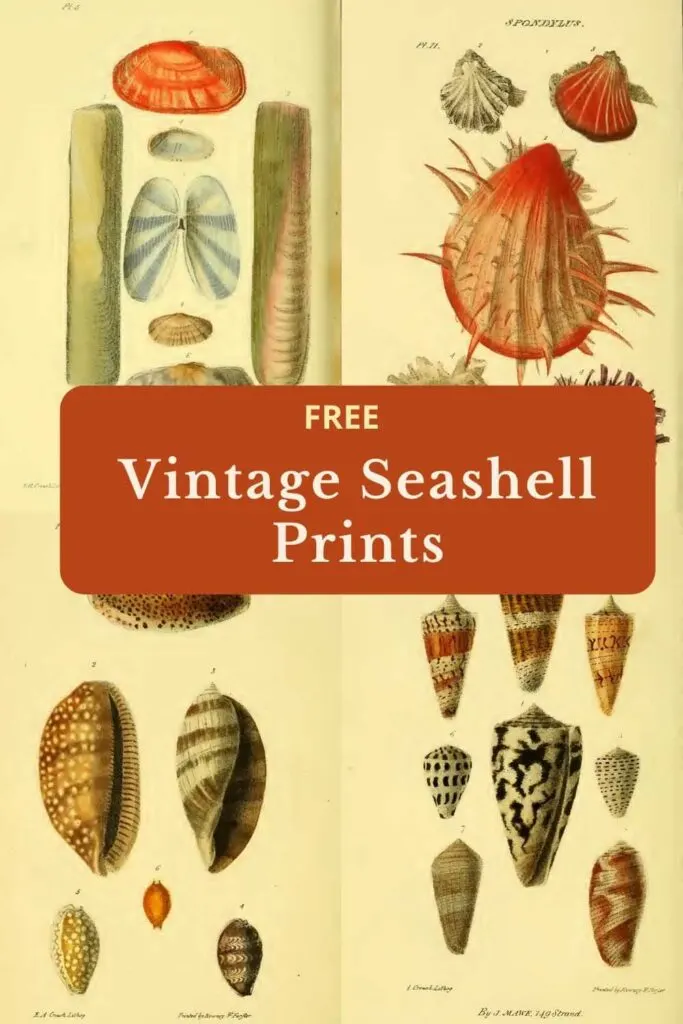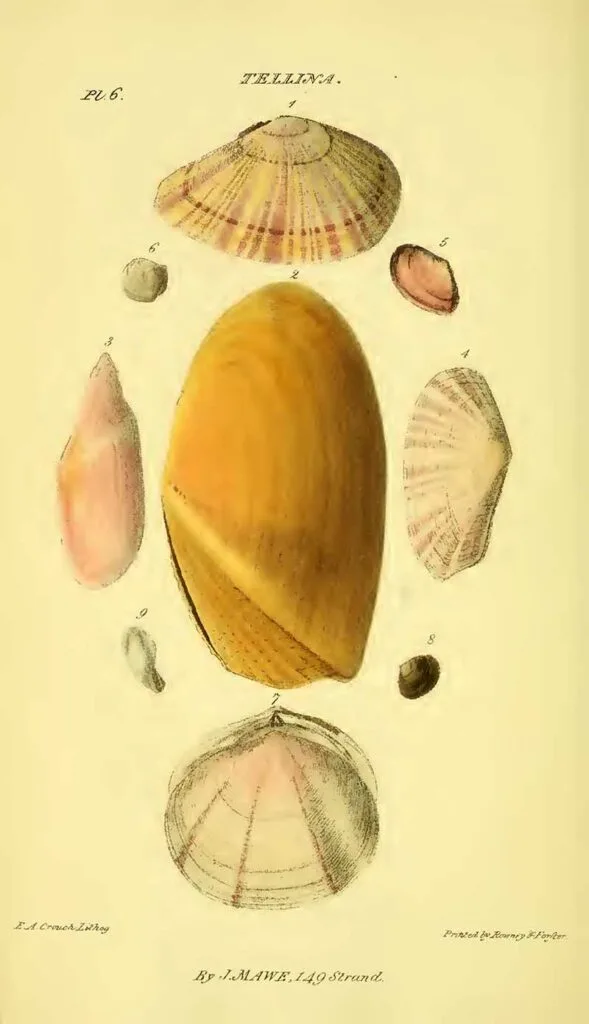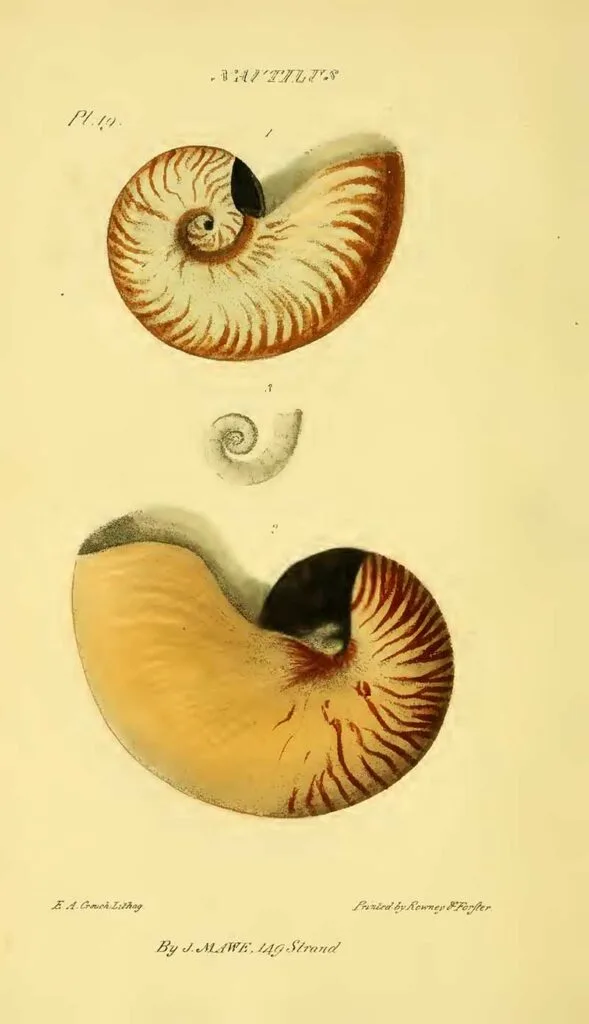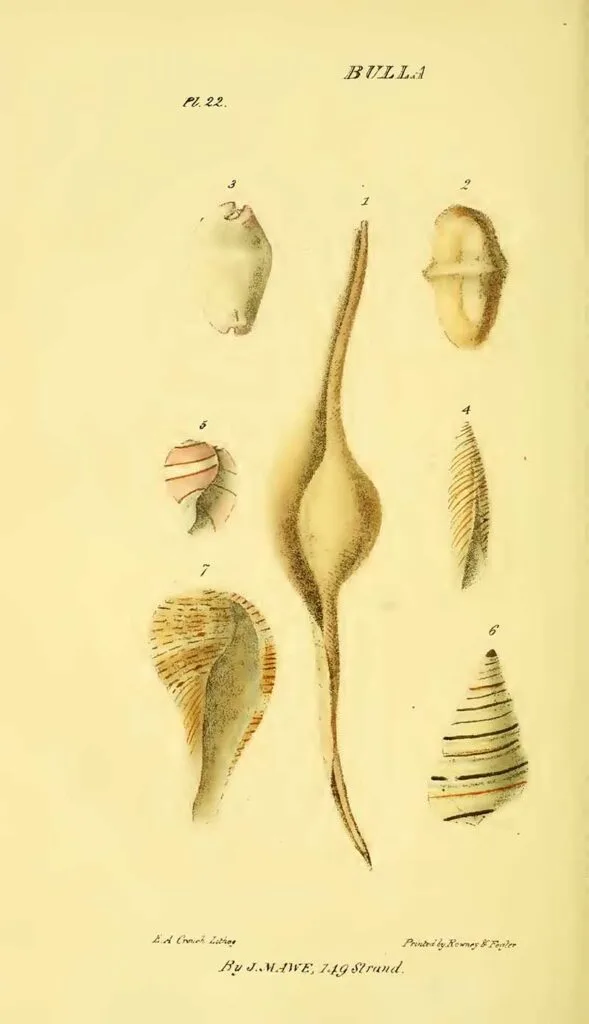I have curated a collection of beautiful 19th Century Conchology prints (seashells) by the British Mineralist John Mawe, from several of his scientific books.
Conchology is the study of mollusc shells only and not the whole organism. Conchologists are basically scientific seashell collectors (freshwater shells too!). For this reason, it is often considered an old fashioned science. As the scientists are only interested in the shell and not the organism inside it. But often this was only part of an exotic organism that was available for them to study.
John Mawe, (1764-1829) wrote the first recognised books on the science of conchology, The Voyager’s Companion or Shell-Collector’s Pilot, & The Linnæan System of Conchology.
The Linnaean system is a scientific way of identifying and classifying specials of animals purely based on their physical similarities. It consists of a hierarchy of taxa, from the kingdom to the species.

The Printable Conchology Prints
These beautiful seashell posters and prints are all in the Public Domain. This means that you are free to print and use them how you wish.
Just click on the title above the shell poster you want to print. A high-resolution image of that seashell poster will open as a new window in your browser. You can then save this image to your device for printing.
Many of the following conchology illustrations are from various editions of “Wodarch’s introduction to the study of conchology: describing the orders, genera, and species of shells: with observations on the nature and properties of the animals and directions for collecting, preserving, and cleaning shells”, by Wodarch, Charles; John Mawe; Crouch, Edmund A.
1. Plate 1 Multivalve and Bivalve seashells
Multivalves are shells with several valves such as Chitons, Lepas and Pholas. Bivalve shells have two hinged valves, they include razor shells, scallops muscles, oysters, cockles and clams.
1 Chiton Squamosus – Scaly Chiton.
2 Lepas Anatifera- Duck Barnacle.
S Lepas Balaiioides – Smooth Acorn Shell.
4 Pholas Dactylus- Prickly Piercer.
5 Mya Truncata- Abrupt Gaper.
6 Tellina Feroensis- Brindled Tellen.
7 Pinna Pectinata- Muricated Pinna.
8 Solen Sanguinolentus – Pink or Rosy Solen.
9 Solen Legumen – Pease-pod Razor Shell.
10 Mytilus Modiolus – Tulip Muscle.
11 Anomia Ephippium – Common English Anomia.
12 Ostrea Opercularis – Common English Pecten.
13 Area Noae – Noah’s Ark.
14 Chama Gigas -Furbelowed Clam.
15 Spondylus Gaedaropus – Thorny Oyster.
16 Venus Chione – Smooth Brown Venus.
17 Donax Denticulata -Toothed Wedge Shell.
18 Mactra Stultorum – Common English Mactra.
19 Cardium Edule – Common Eatable Cockle.

2. Plate 2: Univalves With A Spiral
20 Argonauta Argo- Paper Nautilus.
21 Nautilus Pompilius – Chambered Nautilus.
22 Nautilus Spirula – Spiral or Crozier-headed
Nautilus.
23 Conus Virgo, or Tessel- Mosaic, or Tessellated
latus pavement Cone.
24 Conus Ebraeus – Hebrew Cone.
25 Conus Textile Embroidered -Cloth of
Gold Cone.
26 Cypraea Arabica Nutmeg – Cowry.
27 Cypraea Moneta -Tnissed-fowl, or Black- a- moor’s-tooth Cowry.
28 Cypraea Mus – Mouse Cowry.
29 Bulla Terebellum – Auger, or Borer Bulla.
30 Bulla Naucum – White Bulla, or Dipper.
31 Bulla Lignaria – Wood-grain Bulla.
32 Voluta Utriculus – Common Olive.
33 Voluta Musica – Music Volute.
34 Voluta Episcopal – Bishop’s Mitre.
35 Voluta Persicula – Pigmy Volute.
36 Voluta Tornatilis – Mouse-ear Volute.

3. Plate 3 Conchology Prints
37 Buccinum Patulum – Common, or Wide-mouthed Scoop.
38 Buccinum Dolium- Ribbed Tun.
39 Buccinum Areola – Draft-board Helmet.
40 Strombus Auris-Dianse – Ass’s-ear Alatus.
41 Strombus Pes-Pelicani – Pelican’s-foot Alatus.
42 Murex Tribulus – Thorny Woodcock.
43 Murex Neritoideus – Mulberry.
44 Murex Ramosus – Aculeated Triplex.
45 Trochus Perspectivus – Staircase Trochus.
46 Helix Ampullacea – Apple Snail.
47 Helix Cornea Ram’s-horn Snail

4. Plate 4 Univalve Seashells
48 Turbo Bidens Two-toothed Turbo.
49 Turbo Petholatus-Ribband Turbo.
50 Nerita Virginea – Guinea-hen Nerite.
51 Nerita Plicata – Plaited Nerite.
52 Hahotis Tuberculata – Common Ear Shell.
53 Haliotis Asinum – Ass’s-ear Shell.
54 Haliotis Tuberculata -Outside view of fig 52.
55 Patella Perforata – Perforated Limpet.
56 Patella Vulgata- Common Limpet.
57 Patella Fissura – Cracked Limpet.
58 Patella Sinensis – Chinese bonnet Limpet.
59 Patella Equestris – Cup and-saucer Limpet.
60 Dental ium Striatulum – Striated Tooth Shell.
61 Serpula Aquaria – Watering-pot Serpula.
62 Teredo Navalis – Common Ship Worm.
63 Sabella Belgica -Granulated Sabella.

5. Plate 5: Showing the hinges of Bivalves and other Peculiarities
1 Internal view of the Donax Scortum, shewing the hinge.
2 Internal view of the Solen Siliqua, shewing the hinge.
3 Internal view of the Solen Vespertinus, shewing the hinge.
4 Internal view of the Ostrea Isognomon, shewing the hinge.
5 Internal view of the Pholas Dactylus, shewing the teeth.
6 Internal view of the Pinna Pectinata,
7 Internal view of the Mactra Stultorum, shewing the hinge.
8 Internal view of the Mytilus Hirundo.
9 Internal view of the Mya Aurita, shewing the hinge.
10 Trochus Conchyliophorus, shewing its singular propensity of collecting and affixing shells to itself.
11 Variety of the above, sometimes called the Mineralogist, because it collects stones.

6. Plate 6 Conchology Print
1 Mylilus Edulus, shewing the beard or byssus.
2 Teredo Navahs, shewing the shells imbedded in the wood, which they have perforated.
3 Variety of the Murex Lotorium, shewing its hairy epidermis.
4 Helix Ampullacea, partially covered with its epidermis.
5 Variety of Ostrea Varia, shewing a Serpula adhering to it.
6 Venus Meretrix, shewing the anterior slope.
7 Area Glycimeris, shewing the inside and the hinge.
8 Cardium Lineatum, shewing the inside and the hinge.
9 Internal view of the Anomia Sella, (in a young state), shewing the triangular hinge.
10 Internal view of the Tellina Virgata, shewing the hinge.
11 Internal view of the Spondylus Gaedaropus, shewing the hinge.
12 Internal view of the Chama Cordata, shewing the hinge.
13 A group of Lepas Tintinnabulum.
14 A group of Lepas Anatifera, shewing the peduncles and tentacula.

The next group of vintage conchology prints are from “The Linnæan system of conchology : describing the orders, genera, and species of shells arranged into divisions and families : with a view to facilitate the student’s attainment of the science” by Mawe, John; Crouch, Edmund A., lithographer;
7. Lepas Shells
Lepas shells are those affixed at the base, and consisting of many unequal erect valves.

8. Conchology Prints: Pholas
John Mawe describes Pholas as “Shell having two primary valves, divaricate, with several smaller, differently -shaped accessory valves at the hinge: — hinge recurved, united by a cartilage; in the inside, beneath the hinge, is an in- curved tooth.”

9. Conchology Prints: Mya
Shell bivalve, generally gaping at one end.

10. Seashell Illustrations: Solen
Shell bivalve, oblong, open at both ends: hinge with a subulate re- flected tooth, often double, and not inserted in the opposite valve.

11. Seashell Illustrations: Tellina
Shell bivalve, generally sloping on one side: in the fore part of one valve there is a convex, and in the other a concave fold; hinge with usually three teeth, the lateral smooth in one valve.

12. Conchology Illustrations: Cardium
Shell bivalve, nearly/ equilateral, equivale, generally convex, longitudinally ribbed, or striated, with a crinkled margin: hinge with two teeth near the beak, and a larger remote lateral one on either side, each locking into the opposite valve.

13. Spondylus Seashells
Shell hard, solid, with unequal valves; one of the valves convex, the other rather flat: hinge with two recurred teeth separated by a small hollow.

14. Oystrea, Scallop or Pecten Seashells
Shell bivalve, generally with unequal valves, and slightly eared; hinge without teeth, but furnished with an ovate hollow, and usually with lateral transverse grooves.

15. Nautilus Seashells
Shell univalve, divided into several chambers, communicating with each other by an aperture.

16. Cone Seashells
Shell univalve, convolute, turbinate; aperture effuse, longitudinal, linear, without teeth, entire at the hose; pillar smooth.

17. Cowry Seashell Illustrations
Shell univalve, involute, subovate, smooth, obtuse at each end; aperture effuse at each end, linear, extending the whole length of the shell, and toothed on each side.

18. Conchology Prints: Bulla
Shell univalve, convolute, unarmed with teeth; aperture a little straitened, oblong, longitudinal, very entire at the base; pillar oblique, smooth.

19. Conchology Illustrations: Buccinum
Shell univalve, spiral, gibbous; aperture ovate, terminating in a short canal, leaning to the right, with a retuse beak or projection; pillar-lip expanded.

20: Murex- Rock or Trumpet Shells
Shell univalve, spiral, rough, with membranaceous sutures ; aperture oval, ending in an entire, straight, or slightly ascending canal.

21. Turbo – Wreath or Turban-shell
Shell univalve, spiral, solid ; aperture contracted, orbicular, entire.

If you enjoyed this collection of conchology prints and illustrations don’t forget to check out the other vintage sea life prints on the site. This includes the wonderful sea life posters of Adolphe Millot, Louis Renard’s fantastical fish and some vintage coral reef illustrations.

